Hello,
I was helping a gentleman move a TV into his house and I noticed this sword on his wall. I asked if he knew much about it and he didn't. I then asked if I could borrow it, take some pictures and perhaps find out a little more about it.
I had posted on SBG a similar post, but thought that this forum might attract more historic blade enthusiasts.
[ Linked Image ]
[ Linked Image ][ Linked Image ][ Linked Image ][ Linked Image ][ Linked Image ]
And here are some pictures taken of the blade in the sun:
[ Linked Image ] [ Linked Image ] [ Linked Image ] [ Linked Image ]
Any further information on this blade would be most welcome. The gentleman whom I'm borrowing this from had received this from his father and if I remember correctly, has been in his family for a while. Sadly enough, he was given this instead of an authentic medieval arming sword that his grandfather had procured during his time in Europe.
First impressions are a Horstmann of Philadelphia imported German made Palmetto state (South Carolina militia sword. If you can size those down a bit, they'll attach here. www.onthegosoft.com/shrink_pic.htm A handy tool for sharing images. I apologize for asking but I am on dial up, so these are quite large and time consuming to view. Cameras are way ahead of monitors at this point as well.
Anyway and just my observations, the sword looks to be from the second Seminole period from about 1835 to 1842. The federal period in regard to arms really done after the 1812 warring. The sword is trying really hard to emulate the American made Ames dragoon officer swords but the tell tales of the hilt butt and some other things make me think Horstmann. Oddly or not though, I think the scabbard may be American casting because of the very loud and coarse detail (the older Widmann and transition to Horstmann scabbards much finer works of art. The blade etchings are interesting as a blend of finer needle etching and broader etching. I don't recall seeing the mix with Ames etchings but are found from time to time from other sources.
The palm tree is definitely a South Carolina icon. It could have been a presentation sword but the scabbard art doesn't easily lend to that. There were Mexican war presentation swords as well and within the general timeline but pinning any one sword to any one particular person can be tough. Some fairly affluent militia officer would be my guess.
When first seeing the thumbnails, other thoughts were a very late Philly light horse parade type but the brass scabbard didn't fit that. When seeing the palm, tree and hilt, the Ames 1833 dragoon swords came to mind but why the wrong blade (although it did happen with some presentations) It looked like the 1833 Ames with the 1841 Ames naval blade but then a match with the hilt butt as Horstmann makes me fairly sure about it all.
The general form of the hilt shape goes back to the British 1821 cavalry hilts.
A shame about the blade condition but what can one do at that point but tear up a bit.
Cheers
GC
Anyway and just my observations, the sword looks to be from the second Seminole period from about 1835 to 1842. The federal period in regard to arms really done after the 1812 warring. The sword is trying really hard to emulate the American made Ames dragoon officer swords but the tell tales of the hilt butt and some other things make me think Horstmann. Oddly or not though, I think the scabbard may be American casting because of the very loud and coarse detail (the older Widmann and transition to Horstmann scabbards much finer works of art. The blade etchings are interesting as a blend of finer needle etching and broader etching. I don't recall seeing the mix with Ames etchings but are found from time to time from other sources.
The palm tree is definitely a South Carolina icon. It could have been a presentation sword but the scabbard art doesn't easily lend to that. There were Mexican war presentation swords as well and within the general timeline but pinning any one sword to any one particular person can be tough. Some fairly affluent militia officer would be my guess.
When first seeing the thumbnails, other thoughts were a very late Philly light horse parade type but the brass scabbard didn't fit that. When seeing the palm, tree and hilt, the Ames 1833 dragoon swords came to mind but why the wrong blade (although it did happen with some presentations) It looked like the 1833 Ames with the 1841 Ames naval blade but then a match with the hilt butt as Horstmann makes me fairly sure about it all.
The general form of the hilt shape goes back to the British 1821 cavalry hilts.
A shame about the blade condition but what can one do at that point but tear up a bit.
Cheers
GC
Glen,
This looks like an M1833 dragoon sword to me. What about the blade is wrong to you?
Jonathan
This looks like an M1833 dragoon sword to me. What about the blade is wrong to you?
Jonathan
Hi Jonathan.,
A picture of the blade's tip might say yay or nay. I say nay from what I'm seeing but I have not worked with the image to brighten that a bit. The sword above has a thumb rest/platform and the butt is not as as the Ames. The scabbard toe does look very much like the Ames 1833 officer examples. However the rest of the scabbard is not up to the Ames quality of the brass work. While I just this morning shelved the Ames book after a few days with it I made the note here of the mixed etching panels (or lack of it by Ames)
An article I had found while working with D Z-G regarding the screaming eagles ends with a period account/interview.
http://www.gunandswordcollector.com/Templates...ences.html
"..it is too good a fact to be lost, that the swords sent out to England some years since by the Ameses, or by some of their customers, were not only imitated as exactly as possible, and at once, by their manufacturers, but thought so well of, that the counterfeits came back to this country with even the name of "N.P. Ames" upon them. This was a daring move, and has been discontinued, but we understand the pattern comes constantly still, though without the name. So much for American ingenuity. The compliment may certainly be appreciated, though the trick must, of course, be despised."
Philly retail did work with England as well but I am basing my impression on a Horstmann example in the Medicus collection book. The rounder dome of the pommel and different step of that are what I am regarding and also a pipe back (Although Flayderman never does half of many blades so we can't see the point). Ames ws a quality foundry shop and I do not like the scabbard quality we are seeing as being from the Ames shop. Also that the Ames officer 1833 seem to have been invariably leather with brass mounts.
I do wish someone would buy the current Salter offering. It as well another note of Ames imitation and like the blade above mixed etching panels and work.
http://www.joesalter.com/detail.php?f_qryitem=16506
To me it is kind of a show me the money perspective and that more in regard to the hilt itself, then followed with the scabbard work. 3.5 mb images mean I'll probably not open them all but have seen enough for me to form my opinion. Maybe I am missing something in the Hamilton pages (fresh in mind) but the hilt just don't fly as Ames to me at all.
Cheers
GC
A picture of the blade's tip might say yay or nay. I say nay from what I'm seeing but I have not worked with the image to brighten that a bit. The sword above has a thumb rest/platform and the butt is not as as the Ames. The scabbard toe does look very much like the Ames 1833 officer examples. However the rest of the scabbard is not up to the Ames quality of the brass work. While I just this morning shelved the Ames book after a few days with it I made the note here of the mixed etching panels (or lack of it by Ames)
An article I had found while working with D Z-G regarding the screaming eagles ends with a period account/interview.
http://www.gunandswordcollector.com/Templates...ences.html
"..it is too good a fact to be lost, that the swords sent out to England some years since by the Ameses, or by some of their customers, were not only imitated as exactly as possible, and at once, by their manufacturers, but thought so well of, that the counterfeits came back to this country with even the name of "N.P. Ames" upon them. This was a daring move, and has been discontinued, but we understand the pattern comes constantly still, though without the name. So much for American ingenuity. The compliment may certainly be appreciated, though the trick must, of course, be despised."
Philly retail did work with England as well but I am basing my impression on a Horstmann example in the Medicus collection book. The rounder dome of the pommel and different step of that are what I am regarding and also a pipe back (Although Flayderman never does half of many blades so we can't see the point). Ames ws a quality foundry shop and I do not like the scabbard quality we are seeing as being from the Ames shop. Also that the Ames officer 1833 seem to have been invariably leather with brass mounts.
I do wish someone would buy the current Salter offering. It as well another note of Ames imitation and like the blade above mixed etching panels and work.
http://www.joesalter.com/detail.php?f_qryitem=16506
To me it is kind of a show me the money perspective and that more in regard to the hilt itself, then followed with the scabbard work. 3.5 mb images mean I'll probably not open them all but have seen enough for me to form my opinion. Maybe I am missing something in the Hamilton pages (fresh in mind) but the hilt just don't fly as Ames to me at all.
Cheers
GC
A fancy Ames blade in a brass fitted iron scabbard (another hard one for me to load all the pictures from).
www.angelfire.com/oh3/civilwarantiques/dragoonsaber.html
Attached also a slightly brightened look at the point of the subject sword. The blade looks a good bit slighter overall to me and why I had also considered the narrower naval blade in an 1833 hilt.
I'll look through the Hamilton Ames title again and poke around some more re South Carolina over the weekend. here is that old Pickens thread from SFI for entertainment value.
http://www.swordforum.com/forums/showthread.php?t=80072
Cheers
GC
 Attachment: 46.28 KB
Attachment: 46.28 KB
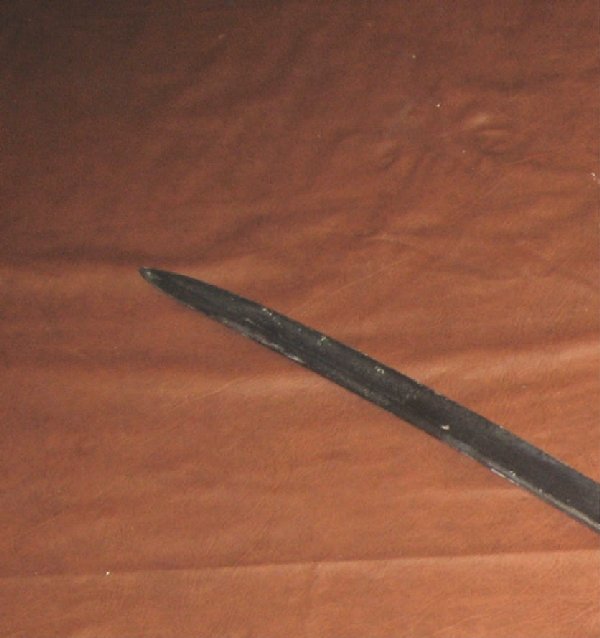
www.angelfire.com/oh3/civilwarantiques/dragoonsaber.html
Attached also a slightly brightened look at the point of the subject sword. The blade looks a good bit slighter overall to me and why I had also considered the narrower naval blade in an 1833 hilt.
I'll look through the Hamilton Ames title again and poke around some more re South Carolina over the weekend. here is that old Pickens thread from SFI for entertainment value.
http://www.swordforum.com/forums/showthread.php?t=80072
Cheers
GC

I'm sorry for my absence while the discussion went along without me. Here is a picture I've taken of just the tip. The caliper measurement was done where the yellow dot is. It appears to be slightly over 0.5"
[ Linked Image ]
[ Linked Image ]
If it is an officer's sword it would not have to be made by Ames to be an M1833, right? I'll have to dig out my copy of Hamilton...
| Jonathan Hopkins wrote: |
| If it is an officer's sword it would not have to be made by Ames to be an M1833, right? I'll have to dig out my copy of Hamilton... |
I do agree there are other Ames combinations and why I had at first considered Ames.There are still some pictures of the hilt that would better put my mind at ease regarding the possibility but as with the blade width the hilt was a real dis-qualifier in my mind. Ames also sold the basic package as a topographical engineer role. That, with the same hilt (along with the officer swords of combinations) use the same hilt over and over without further modification. Overall and as an aside I read time and time again, the role of dragoons was not at all a cavalry only action. Dismounted use of the M1833 also including buglers.
Four angles straight on of the hilt and grip, along with one straight on of the pommel would help a great deal Of two distinct differences from the Ames vs this sword shows of the hilt (in my eyes), a third would be the slot for a sword knot. As with the blade profile overall, the one overall picture posted above leaves a great deal of information and detail to be guessed about.. I would be repeating myself also regarding others emulating the pattern for U.S. consumption. Also mentioning again here re the scabbard itself. The two other differences already mentioned are the raised portion of the backstrap and the butt/pommel itself.
Another WAG could be further exploration of the Palmetto Armory (William Glaze) examples of different (contemporary to the 1840 cavalry and artillery sabers) efforts in the south but I have never read or seen an example of the 1833/1821 type hilt described as coming from that source.
There are an incredible number of 1833 dragoon swords out there for comparison that do show the knot slot from the outside of the guard, the always found on Ames example of the chased lines on the guard, inspectors stamps on the brass and scabbards;
Also in the Hamilton book are the pages of etching along with various presentation swords and the chapter of early officer swords. The eaglehead pommel folding guard Ames naval sword blade also shown. Nor do I recall (from this past week reading it) what should have been regarded a distinctive scabbard from Ames. As mentioned, the Medicus example of this hilt marked to Horstmann along with the possibilities from other sources are heavily weighted observances of mine considering it not done by Ames.
Thanks Greg for the straight on shot of the blade with dimensions. Those five shots of the overall hilt as mentioned above can then be compared to the Ames hilts and even prove it is indeed an Ames effort.
Cheers
GC
I hope that these were the angles you were needing.
[ Linked Image ]
[ Linked Image ]
[ Linked Image ]
[ Linked Image ]
[ Linked Image ]
[ Linked Image ]
[ Linked Image ]
[ Linked Image ]
[ Linked Image ]
[ Linked Image ]
Thanks for those and here is just one handy I downloaded for comparison. Again, anyone can look through listings for comparisons.
The SC militia pattern above (rounded lines lacking crispness or just seriously worn) work from Ames, or from an entirely different source? I would say maybe either way while considering both possibilities. I'll yield on the backstrap variations as the one below does have the thumb ramp. I guess I'll have to read through the book and regard the etchings again myself ;)
Cheers
GC
 Attachment: 35.69 KB
Attachment: 35.69 KB

 Attachment: 70.81 KB
Attachment: 70.81 KB
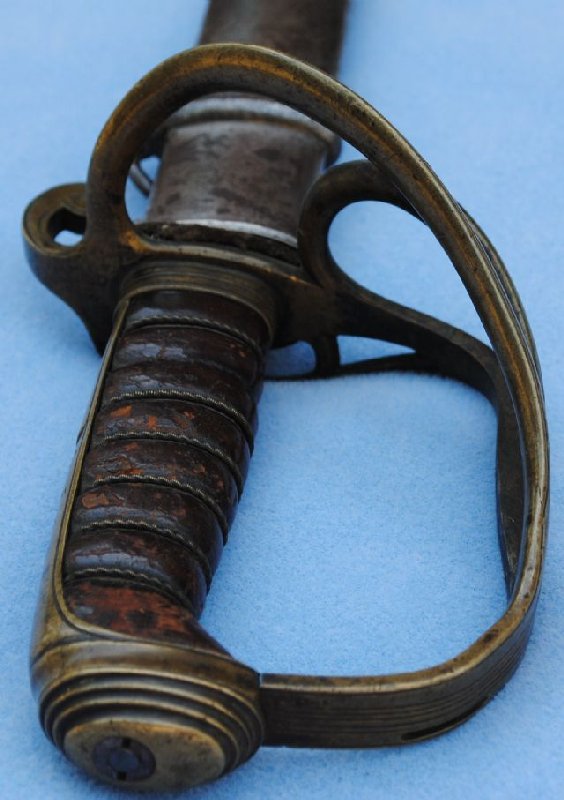
 Attachment: 33.4 KB
Attachment: 33.4 KB
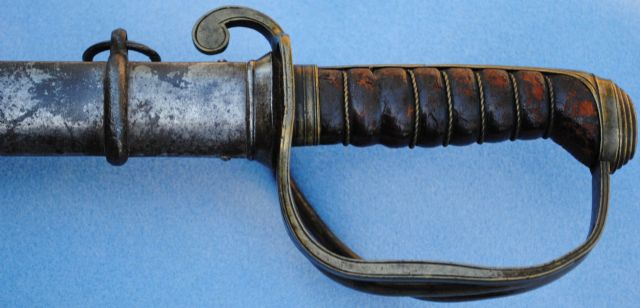
 Attachment: 29.1 KB
Attachment: 29.1 KB
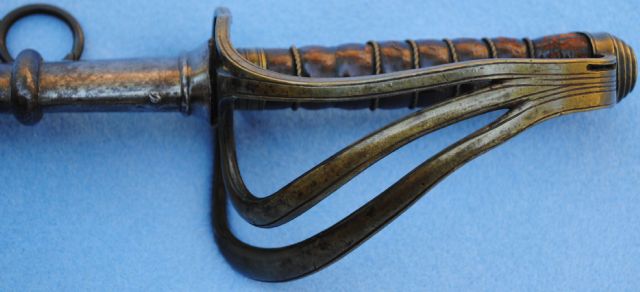
 Attachment: 38.91 KB
Attachment: 38.91 KB
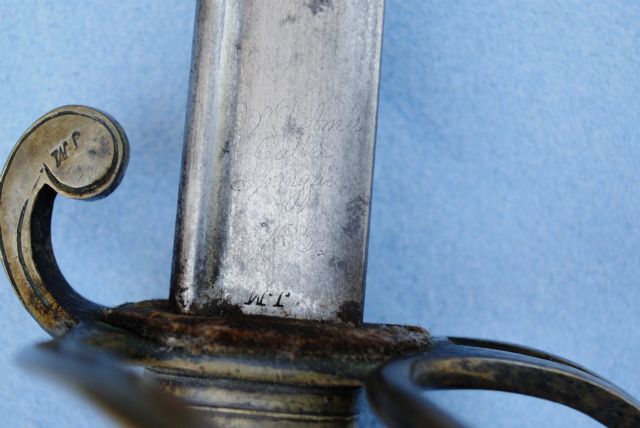
 Attachment: 43.1 KB
Attachment: 43.1 KB
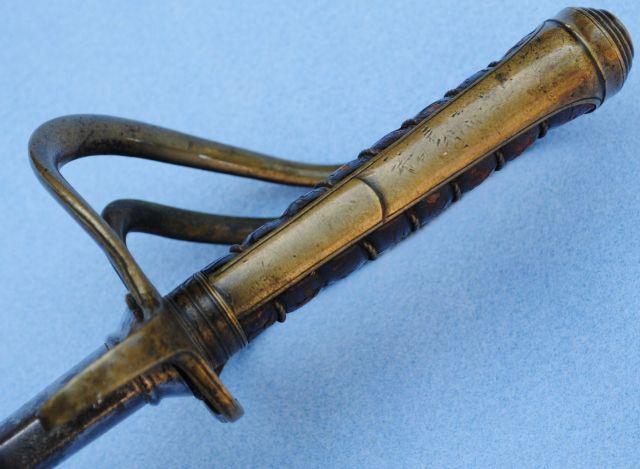
The SC militia pattern above (rounded lines lacking crispness or just seriously worn) work from Ames, or from an entirely different source? I would say maybe either way while considering both possibilities. I'll yield on the backstrap variations as the one below does have the thumb ramp. I guess I'll have to read through the book and regard the etchings again myself ;)
Cheers
GC






Well Greg, I did go ahead and download those other etching photos while going through the book again. In doing so, I have to mention that I am rarely right and that this time I was wrong.
The blade etchings are Ames from the 1830s period and a few paragraphs of interest re South Carolina. Let me transcribe a section of that and not propose it one of a lost sword of great importance but there is some more legwork to be done. Some may be available from the source of the fellow lending you the sword. This may be a quite interesting bit of discovery. I won't relate too much right now of a 56" dragoon blade with a mameluke hilt that was made up for a rather large Kentuckian (7'9"), that one worth some discussion at another time.
"In 1834 the South Carolina State Legislature passed a resolution awarding four swords to native sons who had distinguished themselves during the war with England in 1812. An order for the swords, which were to be similar in form to one previously made for Col. Abbott H. Brisbane (1805-1861), was forwarded to the Ames shop in September 1835. Col Brisbane an engineer on topographical duty, had been in command of South Carolina Volunteers during the Seminole Wars in 1835-36. One of the South Carolina presentation swords (in the collection of the National Museum) was awarded to William B. Shubrick (1790-1874), Capt, USN, who had served as Third Lieutenant aboard the frigate Constitution during the capture of the British Vessel CYANE and LEVANT on 23 February, 1815. Shurbrick's sword, awarded for his part in the action, was described in the IOWA HAWKEYE as having cost $750. While the papers of the period were prone to inflate the value of presentation swords, figures quoted were seldom far from the truth. the South Carolina swords were completed and shipped out in October 1838, together with another parcel of swords destined for Texas"
I am not remembering quickly which Constitution sword was in the media in the past several years but Shubrick's presentation sword should be able to be found photographically in reference somewhere (maybe in another book I have here).
I don't want to say the sword of this thread is one of those four but it may well be.
More later and thanks Greg for sharing this (even with the monster photos but I'll get over that someday).
Cheers
GC
A note on transcribing from texts and possible blinders, I am reading now a New York Times account of the John T Shubrick presentation sword. Go figure and another hmmmmm about all this. Or that there are actually two Shubricks awarded swords for actions during the war of 1812. yowsa
.
The blade etchings are Ames from the 1830s period and a few paragraphs of interest re South Carolina. Let me transcribe a section of that and not propose it one of a lost sword of great importance but there is some more legwork to be done. Some may be available from the source of the fellow lending you the sword. This may be a quite interesting bit of discovery. I won't relate too much right now of a 56" dragoon blade with a mameluke hilt that was made up for a rather large Kentuckian (7'9"), that one worth some discussion at another time.
"In 1834 the South Carolina State Legislature passed a resolution awarding four swords to native sons who had distinguished themselves during the war with England in 1812. An order for the swords, which were to be similar in form to one previously made for Col. Abbott H. Brisbane (1805-1861), was forwarded to the Ames shop in September 1835. Col Brisbane an engineer on topographical duty, had been in command of South Carolina Volunteers during the Seminole Wars in 1835-36. One of the South Carolina presentation swords (in the collection of the National Museum) was awarded to William B. Shubrick (1790-1874), Capt, USN, who had served as Third Lieutenant aboard the frigate Constitution during the capture of the British Vessel CYANE and LEVANT on 23 February, 1815. Shurbrick's sword, awarded for his part in the action, was described in the IOWA HAWKEYE as having cost $750. While the papers of the period were prone to inflate the value of presentation swords, figures quoted were seldom far from the truth. the South Carolina swords were completed and shipped out in October 1838, together with another parcel of swords destined for Texas"
I am not remembering quickly which Constitution sword was in the media in the past several years but Shubrick's presentation sword should be able to be found photographically in reference somewhere (maybe in another book I have here).
I don't want to say the sword of this thread is one of those four but it may well be.
More later and thanks Greg for sharing this (even with the monster photos but I'll get over that someday).
Cheers
GC
A note on transcribing from texts and possible blinders, I am reading now a New York Times account of the John T Shubrick presentation sword. Go figure and another hmmmmm about all this. Or that there are actually two Shubricks awarded swords for actions during the war of 1812. yowsa
.
Unfortunately no picture of the Shubrick sword but here is some text decribing it as not of the pattern of this thread's example.
"SWORD OWNED BY REAR ADMIRAL WILLIAM B. SHUBRICK
A third presentation naval sword connected with the War of
1812 is one ^* presented by the State of South Carolina in 1834 to
Capt. William B. Shubrick, United States Navy, in recognition of
services during that conflict. The blade is long and straight with
tAvo edges and convex sides. The obverse bears in silver chasing a
palm tree, a ship under full sail, oak sprays, and the inscription
" Caf)t. Wm. B. Shubrick, U. S. N." The reverse is similarly deco-
rated with the United States arms, a marine trophy, including a
ship's topmast, crossed cannon, and a foul anchor and floral and
scroll designs. The general shape of the hilt is identical with that
of the military paymaster's sword previousl}^ described. The grip,
however, is gold mounted and urn-shaped. The top of the urn,
which constitutes the pommel, represents a pineapple; the body or
central portion has four sides, two of which are decorated with laurel
leaves and two with oak leaves and acorns ; the bottom is surrounded
with oak-leaf scrolls. One side of the top bears a foul anchor and
the other an oval shield inscribed : " The State of South Carolina to
Capt. W. B. Shubrick, U. S. N."
The quillons consist of oak-leaf scrolls, and a large shield on the
obverse bears a palmetto tree in high relief. A similar shield on the
reverse is inscribed in 26 lines : " Eesolution of 1834 ; Resolved that
the governor be authorized to purchase and cause to be presented to
Capt. Wm. B. Shubrick, of the U. S. Navy and a native of S. Caro-
" Length, 95 cm. Blade, 79 cm. long, 2 cm wide. PI. 31, fig. 3.
U. S. NATIONAL MUSEUM "
So anyway, it doesn't look like the sword in discussion here is one of those four,
"SWORD OWNED BY REAR ADMIRAL WILLIAM B. SHUBRICK
A third presentation naval sword connected with the War of
1812 is one ^* presented by the State of South Carolina in 1834 to
Capt. William B. Shubrick, United States Navy, in recognition of
services during that conflict. The blade is long and straight with
tAvo edges and convex sides. The obverse bears in silver chasing a
palm tree, a ship under full sail, oak sprays, and the inscription
" Caf)t. Wm. B. Shubrick, U. S. N." The reverse is similarly deco-
rated with the United States arms, a marine trophy, including a
ship's topmast, crossed cannon, and a foul anchor and floral and
scroll designs. The general shape of the hilt is identical with that
of the military paymaster's sword previousl}^ described. The grip,
however, is gold mounted and urn-shaped. The top of the urn,
which constitutes the pommel, represents a pineapple; the body or
central portion has four sides, two of which are decorated with laurel
leaves and two with oak leaves and acorns ; the bottom is surrounded
with oak-leaf scrolls. One side of the top bears a foul anchor and
the other an oval shield inscribed : " The State of South Carolina to
Capt. W. B. Shubrick, U. S. N."
The quillons consist of oak-leaf scrolls, and a large shield on the
obverse bears a palmetto tree in high relief. A similar shield on the
reverse is inscribed in 26 lines : " Eesolution of 1834 ; Resolved that
the governor be authorized to purchase and cause to be presented to
Capt. Wm. B. Shubrick, of the U. S. Navy and a native of S. Caro-
" Length, 95 cm. Blade, 79 cm. long, 2 cm wide. PI. 31, fig. 3.
U. S. NATIONAL MUSEUM "
So anyway, it doesn't look like the sword in discussion here is one of those four,
Ah, that is to bad. I was hoping to return the sword with the possibility of it being a part of historic significance rather then just a part of history.
I do thank you for all of the time and energy (and bandwidth) you've devoted to helping me. I do feel comfortable that we have learned a great deal about this sword and that the gentleman that had lent it to me will be very enthusiastic to know even a little bit more about the blade.
I will be returning it to him soon, so any over sized pictures would take a while longer to procure.
Again, you have my utmost thanks for your efforts in identifying this piece.
I do thank you for all of the time and energy (and bandwidth) you've devoted to helping me. I do feel comfortable that we have learned a great deal about this sword and that the gentleman that had lent it to me will be very enthusiastic to know even a little bit more about the blade.
I will be returning it to him soon, so any over sized pictures would take a while longer to procure.
Again, you have my utmost thanks for your efforts in identifying this piece.
What a fine thread! Thanks for all the research work and sharing.
| Greg Heim wrote: |
| Ah, that is to bad. I was hoping to return the sword with the possibility of it being a part of historic significance rather then just a part of history.
I do thank you for all of the time and energy (and bandwidth) you've devoted to helping me. I do feel comfortable that we have learned a great deal about this sword and that the gentleman that had lent it to me will be very enthusiastic to know even a little bit more about the blade. I will be returning it to him soon, so any over sized pictures would take a while longer to procure. Again, you have my utmost thanks for your efforts in identifying this piece. |
It really is a significant sword though in that the sword itself is not in a book yet. Although we can determine it to be an Ames, the South Carolina connection is uncommon enough when combined with the timeline to warrant more research by the owner (and even my own poking about).
The kudos really go to Jonathan though for poking me in the ribs while I am in denial while having just had the book open. I tend to overcompensate in the "can't possibly be" while fixating on other possibilities. More reading yesterday in Hamilton's Ames history more neatly encapsulates a lot of notes I had been assembling before owning or even briefly reading through the volume. Considering that the tile is almost thirty years old, it is amazing the research and effort he must have riffled through without the advent of the internet as we know it now. There are a few biographical notes about the Ames family that are not in the book but what is there is spot on to other sources I have come across.
As to the history and significance of the piece, without finding out more; who is to say really? It is a sword interesting enough that John Hamilton himself might be interested in taking a look at. He may well have come into more information on these but as near as I can tell, the most recent (sold out) reprint of the 1980s title was not amended at all. The bits and pieces we uncover now in seeing these swords surface is what the sharing and learning is all about. There is no harm at all in posting it around to other forums that might tickle a memory. SFI and quite particularly Don Furr over at http://www.antiqueguns.com/phorum/list.php?8 While I have not seen him post lately, if he is still well I am sure he is reading. The www.vikingsword.com forum as well that but can be a wait in the registration process.
Cheers
GC
Page 1 of 1
You cannot post new topics in this forumYou cannot reply to topics in this forum
You cannot edit your posts in this forum
You cannot delete your posts in this forum
You cannot vote in polls in this forum
You cannot attach files in this forum
You can download files in this forum
All contents © Copyright 2003-2006 myArmoury.com — All rights reserved
Discussion forums powered by phpBB © The phpBB Group
Switch to the Full-featured Version of the forum
Discussion forums powered by phpBB © The phpBB Group
Switch to the Full-featured Version of the forum